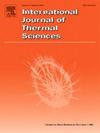Forced convection in laminar flow with nonlinear viscoelastic fluids in non-circular ducts including viscous dissipation: Giesekus fluids
IF 4.9
2区 工程技术
Q1 ENGINEERING, MECHANICAL
International Journal of Thermal Sciences
Pub Date : 2025-03-27
DOI:10.1016/j.ijthermalsci.2025.109873
引用次数: 0
Abstract
Heat transfer enhancement for a steady, laminar, incompressible and axially fully developed flow of nonlinear viscoelastic shear-thinning fluids abiding by the Giesekus constitutive structure in straight microtubes of arbitrary non-circular contour under constant heat flux at the walls is investigated. The governing equations are solved based on an embedded double asymptotic series expansion pivoted around the elasticity measure Weissenberg number and a mapping parameter The effects of the constitutive parameters of the Giesekus model as well as the dimensionless flow parameters on the flow and heat transfer in microtubes of a wide-ranging spectrum of non-circular cross-sectional contours are investigated. The flow and thermal fields of representative tubes with equilateral triangular, square, rectangular, and pentagonal cross-sections are investigated in detail. The analysis reveals that the constitutive mobility parameter , viscosity ratio and the Weissenberg number significantly influence the Nusselt number together with the flow characteristics, the Péclet Pe, Brinkman Br and Reynolds Re numbers. Effects of the viscous dissipation in wall cooling and wall heating is studied. At a given value of heat transfer is enhanced regardless the process considered at the boundary. In all cases, heat transfer is improved compared to Newtonian fluids, with the strongest enhancement observed in rectangular microtubes for low-inertia flows.
含粘性耗散的非圆形管道中非线性粘弹性流体层流中的强迫对流:Giesekus流体
研究了任意非圆形状直线微管中具有Giesekus本构结构的非线性粘弹性剪切减薄流体在恒壁面热流密度条件下的稳定、层流、不可压缩、轴向充分展开的强化传热问题。控制方程的求解基于以弹性测度Weissenberg数Wi和映射参数ε为中心的嵌入式二重渐近级数展开。研究了Giesekus模型的本构参数和无量纲流动参数对宽谱非圆截面微管内流动和传热的影响。详细研究了具有代表性的等边三角形、方形、矩形和五边形截面管的流场和热场。分析表明,本构迁移率参数α、黏度比β和Weissenberg数Wi对Nusselt数Nu、流动特性、psamclet Pe、Brinkman Br和Reynolds Re数均有显著影响。研究了壁面冷却和壁面加热过程中粘性耗散的影响。在给定的Wi值下,无论在边界处考虑何种过程,传热都得到加强。在所有情况下,与牛顿流体相比,传热都得到了改善,在矩形微管中观察到的低惯性流动的强化效果最强。
本文章由计算机程序翻译,如有差异,请以英文原文为准。
求助全文
约1分钟内获得全文
求助全文
来源期刊

International Journal of Thermal Sciences
工程技术-工程:机械
CiteScore
8.10
自引率
11.10%
发文量
531
审稿时长
55 days
期刊介绍:
The International Journal of Thermal Sciences is a journal devoted to the publication of fundamental studies on the physics of transfer processes in general, with an emphasis on thermal aspects and also applied research on various processes, energy systems and the environment. Articles are published in English and French, and are subject to peer review.
The fundamental subjects considered within the scope of the journal are:
* Heat and relevant mass transfer at all scales (nano, micro and macro) and in all types of material (heterogeneous, composites, biological,...) and fluid flow
* Forced, natural or mixed convection in reactive or non-reactive media
* Single or multi–phase fluid flow with or without phase change
* Near–and far–field radiative heat transfer
* Combined modes of heat transfer in complex systems (for example, plasmas, biological, geological,...)
* Multiscale modelling
The applied research topics include:
* Heat exchangers, heat pipes, cooling processes
* Transport phenomena taking place in industrial processes (chemical, food and agricultural, metallurgical, space and aeronautical, automobile industries)
* Nano–and micro–technology for energy, space, biosystems and devices
* Heat transport analysis in advanced systems
* Impact of energy–related processes on environment, and emerging energy systems
The study of thermophysical properties of materials and fluids, thermal measurement techniques, inverse methods, and the developments of experimental methods are within the scope of the International Journal of Thermal Sciences which also covers the modelling, and numerical methods applied to thermal transfer.
 求助内容:
求助内容: 应助结果提醒方式:
应助结果提醒方式:


